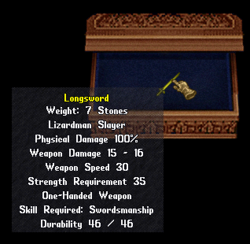Slayer
Contents
- 1 Slayer Opposites
- 2 History
- 3 Super & Lesser Slayers
- 4 Creature Slayer Charts
- 4.1 Demon Slayer
- 4.2 Elemental Slayer
- 4.3 Fey slayer
- 4.4 Arachnid Slayer
- 4.5 Reptile Slayer
- 4.6 Repond Slayer
- 4.7 Goblin Slayer
- 4.8 Vermin Slayer
- 4.9 Undead Slayer
- 4.10 Mage Slayer (a subset affected by both Undead & Mage)
- 4.11 Eodon Slayer
- 4.12 Bat Slayer
- 4.13 Bear Slayer
- 4.14 Beetle Slayer
- 4.15 Bird Slayer
- 4.16 Bovine Slayer
- 4.17 Flame Slayer
- 4.18 Ice Slayer
- 4.19 Mage Slayer
- 4.20 Wolf Slayer
- 5 See Also
The Slayer property is found on certain melee weapons, instruments, talismans, and spellbooks. This property will do the following when used in an offensive manner:
- Increases damage done to the monsters/group they are meant for, in a manner described below;
- Cause most spells to do double damage to the monsters they are meant for;
- Slayer instruments will increase your success chance by 20% when used on the creatures it is meant for;
- Slayer instruments will decrease your success chance by 20% when used on the creatures from its opposing group; and
- Successful use of a slayer weapon, spellbook, or musical instrument will yield a little white flash on the monster.
The Slayer property can be found as a rare drop in monster loot or crafted by a character when using Runic Tools. Slayer instruments can only be found on monster loot. A slayer spellbook however can only be crafted by scribes using a scribe pen (assuming they have a high level of magery) or in artifact form.
Player crafted spellbooks have a chance to have properties from any slayer groups. You must have the spellbook equipped to receive the double damage bonus from most direct damage spells, and slayers granted by spellbooks only effect spells that make use of Evaluating Intelligence in their damage formulas (notable exceptions are Mind Blast and Harm). Note that Necromancy and Spellweaving spells are also not included.
There are two types of slayers, Super Slayers and Lesser Slayers. Super Slayers are effective against a large group of different, but racially or elementally similar, creatures. The Super Slayer comes in two forms: Talisman-based and instrument/spellbook/weapon-based.
Talisman Slayers do not affect spells. The Damage Increase from both talisman-based and instrument/spellbook/weapon-based forms is cumulative, or stacks, subject to the 300% cap.
- The following Super Slayers primarily are found on Talisman: Bat, Bear, Beetle, Bird, Bovine, Flame, Ice, Mage, Vermin, & Wolf.
- The following Super Slayers primarily are found on musical instruments, weapons, and spellbooks: Abyss, Arachnid, Elemental, Fey, Repond, Reptile, and Undead Slayer.
Slayer Opposites
In a mechanic of the game that was long thought dormant but not, each slayer type has an "opposite." Wielding a slayer type against its opposite will cause the attacker to take more damage then he or she would otherwise. For example, using an Undead Slayer against a humanoid (Repond) will cause the attacker to take additional damage from the humanoid. The same applies to using an Ophidian Slayer against a Terathan. (This limits the usefulness in combat of the Berserker's Bardiche, an artifact found during the Ophidian War event cycle.)
History
- Initially, the Slayer property was called Virtue Weapons, applied only to melee weapons, and operated in a far different manner than currently.
- The very first Slayer weapons in the game were Undead slayers, but were known as Silver weapons.
- Publish 16 (July 12-22, 2002) saw the introduction of Slayer Musical Instruments. They they worked the same way as Slayer melee weapons. However, they increased the chance of a successful use of the Barding skill that was mentioned in the tool tip, instead of doing double damage to the creatures for they were meant.
- The Ultima Online: Age of Shadows (February 2003) expansion changed the way Slayer weapons work, to the current manner.
- The Slayer Spellbooks were released with Publish 31 (March 17, 2005) as part of an attempt to make mages more balanced in PvE.
Super & Lesser Slayers
Super Slayers apply to whole groups of creatures. The Lesser Slayers are creature specific. They will say the name of the creature then slayer. For example: "Lizardman Slayer."
Until the Stygian Abyss expansion, all Slayers did double damage to applicable monsters. However, following that expansion, Lesser Slayers do triple damage, and Super Slayers still do double damage. The manufacturers stated explicitly that this was intended to increase the value of the Lesser Slayers, which were increasingly looked down upon by players (with a few notable exceptions, such as Scorpion Slayer, Spider Slayer, and Dragon Slayer, all of which had particular uses).
Slayer Spellbook Examples using Corp Por:
Normal Spellbook Energy Bolt vs. Ancient Wyrm: 35 Damage
Reptile Slayer [Super Slayer] vs. Ancient Wyrm: 70 Damage
Dragon Slayer [Lesser Slayer] vs. Ancient Wyrm: 110+ Damage
[Personal record is 240+ Damage with Flame Strike, Dragon Slayer +9% spell book vs. Cold Drake]
Creature Slayer Charts
|
| ||||||||||||||||||||||||
|
| ||||||||||||||||||||||||
| |||||||||||
|
|
| |||||||||||||||
|
|
| |||||||||||||||
|
|
| |||||||||||||||
See Also
| Slayers | |
|---|---|
| Double Damage Super Slayers
(with opposing groups) |
Abyss • Arachnid • Elemental • Fey • Repond • Reptile • Undead |
| Double Damage Super Slayers |
Bat • Bear • Beetle • Bird • Bovine • Dinosaur • Eodon Tribes • Eodon • Flame • Goblin • Ice • Mage • Myrmidex • Vermin • Wolf |
| Triple Damage Slayers |
Air Elemental • Blood Elemental • Dragon • Earth Elemental • Fire Elemental • Gargoyle • Lizardman • Ophidian • Orc • Ogre • Poison Elemental • Scorpion • Snake • Snow Elemental • Spider • Terathan • Troll • Water Elemental |
